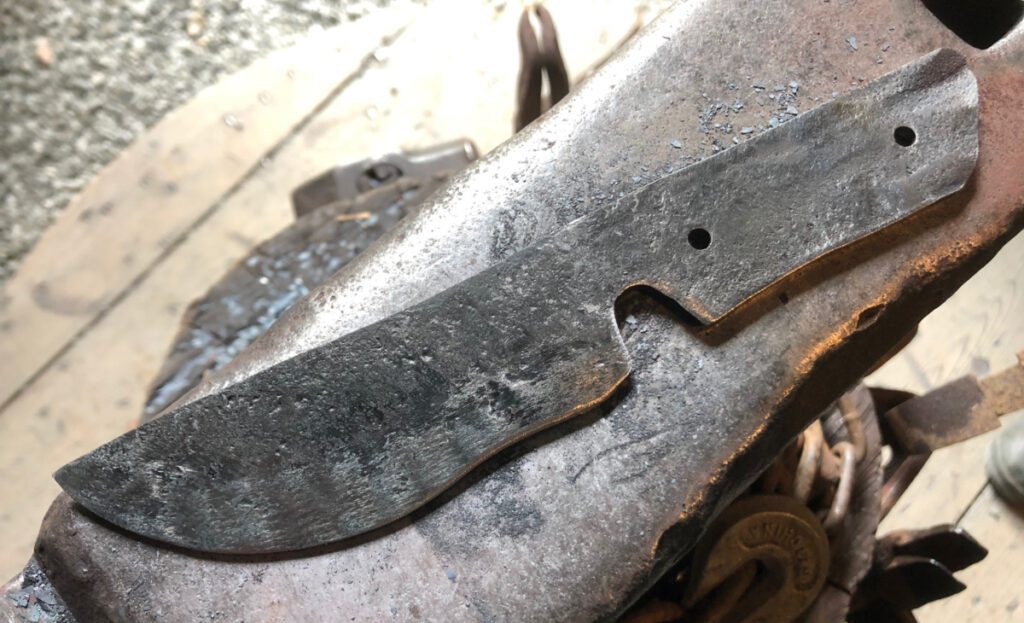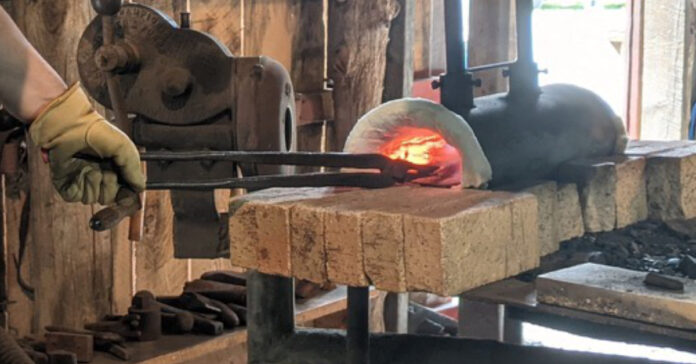The Bible verse Joel 3:10 says, “Beat your plowshares into swords and your pruning hooks into spears: let the weak say, I am strong.”
I spent a morning last week beating a lawnmower blade into a rough knife shape. After three hours of forging and grinding, I have much greater respect for anyone who can fashion a decent blade from a hunk of raw metal. I’m also pretty certain that while I might be able to fashion a pruning hook into a spear, I could not beat a plowshare into a sword.
Forging is much harder than it looks on all those TV shows and YouTube videos.
Flattening the Blade
I picked a lawnmower blade as my starting point because it was the appropriate thickness. Granted, that is not the normal criteria you would choose to pick your steel, but I had only a few hours. I felt starting with a material of the right thickness would give me a head start. A bladesmith would buy a particular type of steel that matches the intended use of the finished blade, but that wasn’t an option in my case. Plus, I was approaching this exercise from a survival perspective. In a Post-SHTF situation, leaf springs from cars, lawnmower blades, railroad spikes, vehicle parts, and similar found materials are going to be what we have available as raw material sources.
My first task was to flatten the blade, which was bent in multiple paces and directions. I did this by repeatedly heating the blade in the propane forge (see main image) and hammering it on the anvil to flatten the bends out of it. Being new to this process, I often ended up hammering my own bends in the metal. The forge owner gave me some tips, and by working on different parts of the anvil and turning the blade 90 degrees, I was able to get flattened.
Shaping the Knife
After waiting for the blade to cool, I used a piece of chalk to trace the outline of my desired blade and tang shape onto the metal blank. Then I used a grinder to cut away the excess steel, leaving a rough outline of what I hoped my finished knife would look like.
Is using a grinder cheating? I felt like it was, but it beat placing the hot steel on a wedge and hammered through to cut the knife shape out. This isn’t the 1800s, and I didn’t have all day. I also left the other end of the lawnmower blade on the butt-end of the knife, so I had something for the tongs to grab.
Let me also take a moment to apologize to any professionals out there. I have no training, no experience, and I am pretty sure I am not using the correct jargon or terminology. Everyone is new on their first day.
After shaping the knife, it was back into the forge where I would heat the metal until it was yellow hot. I would remove it from the forge with tongs and hammer it with a smaller, lighter hammer, tilting the face of the hammer to draw the metal out and thin the cutting edge. This was time consuming, but I was successful. In fact, the point of the knife turned upward as the metal stretched. Tht was OK; I knew I could grind it off.
Finalizing the Shape
As I was drawing near the end of my forge time, I had to let the blade cool and then used both a grinder and a giant belt sander to get the final shape to my liking. Then I used a drill press to drill two holes in the tang for my future handle.
After shaping, I re-heated the blade in the forge, testing it with a magnet until it was hot enough, and quenched it in warm oil. Then I carefully inserted it back into the forge to warm up and let it gradually cool down. Later, I can anneal it further on my own.
My Final Product
I walked away with a blade that is generally the size and shape I wanted, but it is unfinished. (For info on what I wanted my blade to look like, see my prior post.)

Could I sharpen it? Yes.
Could I wrap the tang in rawhide or paracord and have a knife I could use to stab or cut someone? Yep.
Did I have fun making it? Definitely.
Am I satisfied with the finished result? Not yet. I am afraid this is not the perfect blade I had envisioned.
Would I carry it in a survival situation? Only if I had no other knife. It’s better than a pointy stick, but for now I’ll stick to my commercial blades.
When I have some spare time, I’ll use my file to make it look flatter, shinier, and prettier. Then I’ll shape a handle for it from a piece of maple I have that is about the right size and epoxy it into place. Maybe I can still end up with a usable piece, but I think I need a couple months of instruction and practice before I can forge a knife that looks good and performs well.
Survival Forging
There’s a reason prosperous villages had a smith prior to the industrial revolution. A few years after the power goes out for good, the remnant population will need a smith to repair old items, construct new ones, weld, shape, and sharpen.
I have no doubt that forging would be an excellent skill to have when things calm down after a global SHTF situation, but I learned enough to know it’s not for me. I’d have needed to start at least 20 or 30 years younger. Thankfully, I’ve got enough knives that I don’t expect I will ever need to forge one, and that’s probably a good thing!
If you want to be a SHTF blacksmith, you’d better be prepared for that. Make it your hobby or a side gig. Polish your skills now, while it’s not a matter of life or death. Build up your collection of hand tools, get your anvil, find or build a coal forge, get a gigantic pile of coal delivered, and make sure you have an apprentice or two who can pump the bellows. It’s going to be a different process after TEOTWAWKI when there are no propane forges, electric belt sanders, power grinders, or electric blowers, but you’ll be the go-to guy.
In the meantime, remember that those who beat the swords into plowshares will plow for those who don’t.








